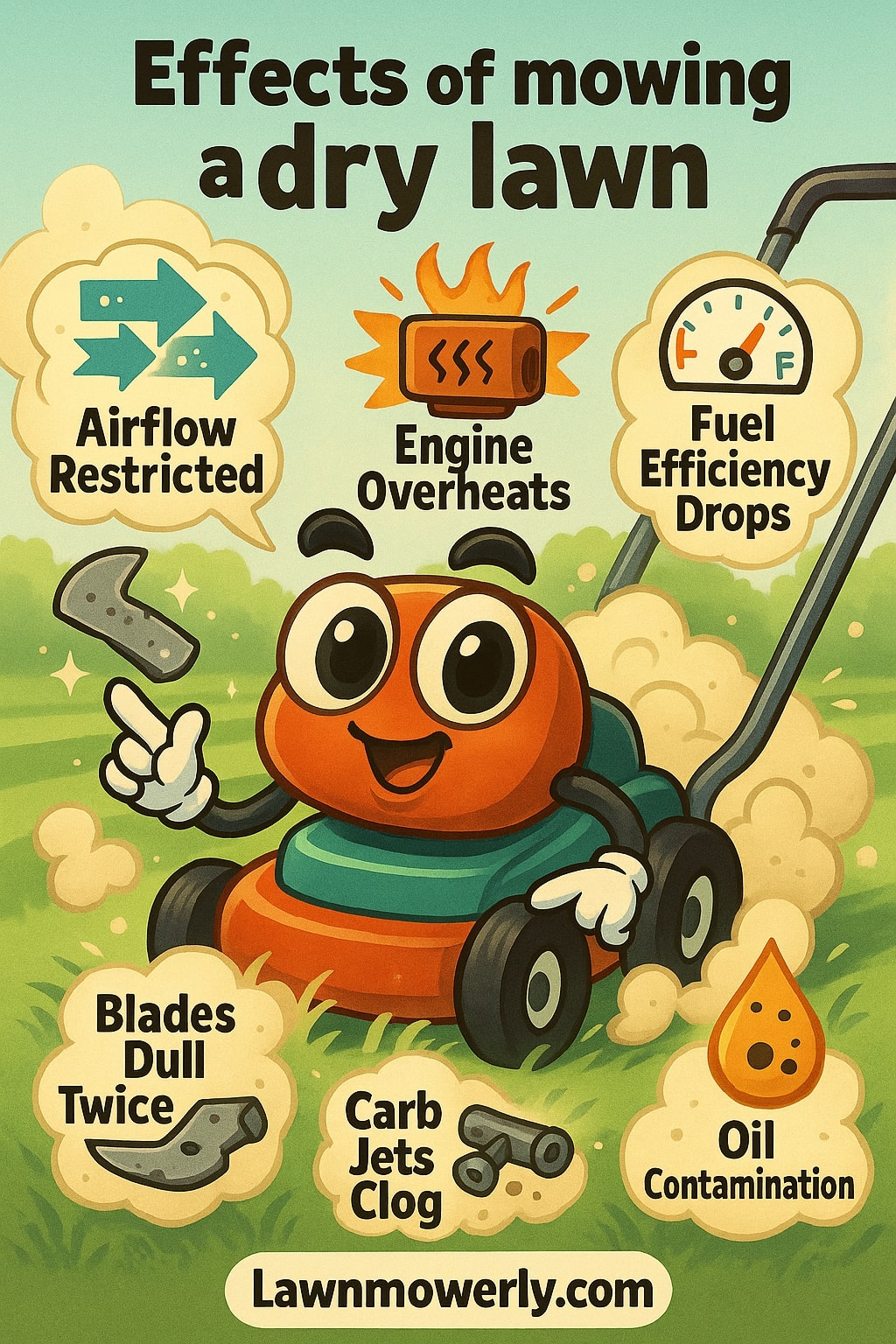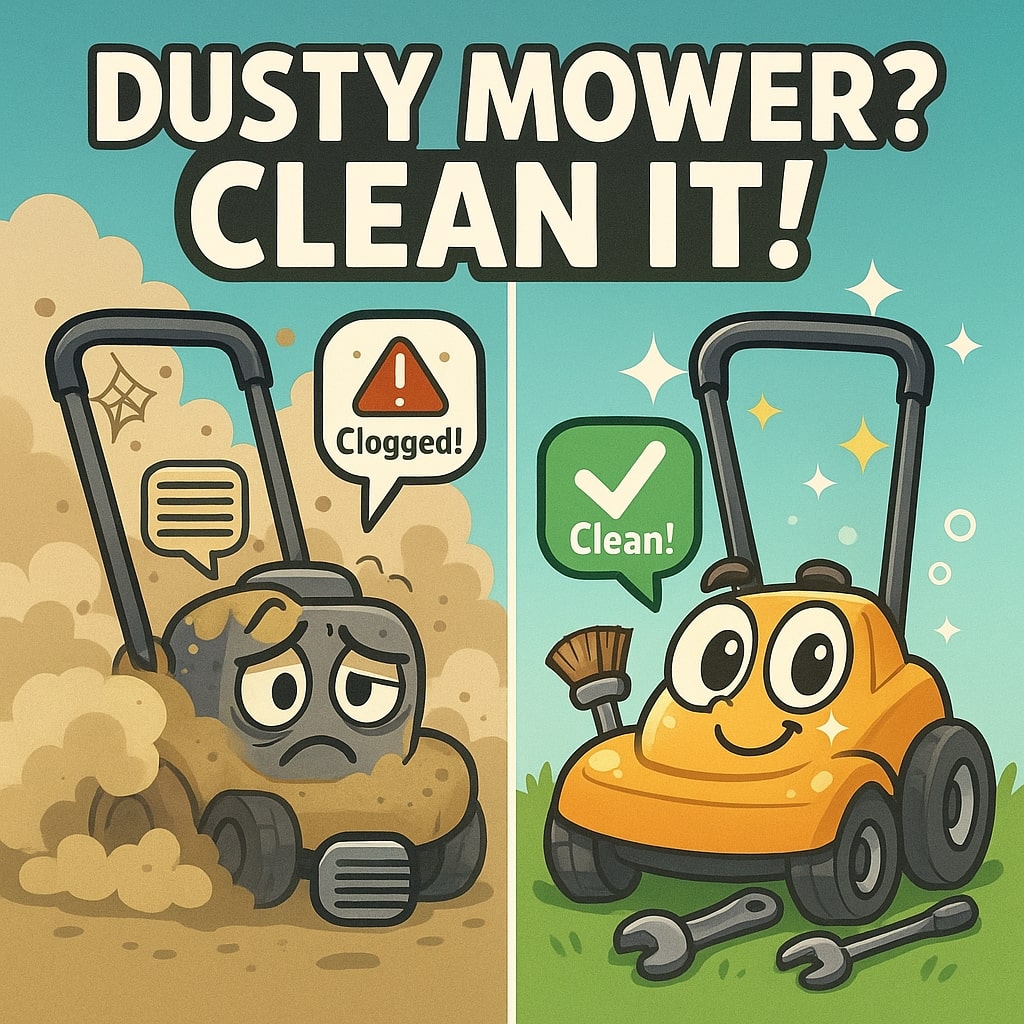
If you’ve just mowed a dry, dusty lawn—maybe a construction-site yard, a drought-hit patch in the Southwest, or a fall leaf–covered Midwest turf—your mower just went through one of the toughest conditions it can face.
Dusty mowing forces your mower to inhale dirt, choke its air filter, dull its blades, clog its deck, and even wear down internal engine components faster than normal. That’s why post-dust lawn mower maintenance isn’t optional—it’s essential if you want your machine to last, cut cleanly, and avoid expensive repairs down the road.
This guide breaks down exactly what to do immediately after dusty mowing, along with engine care, cleaning steps, US climate-specific recommendations, and expert tips used by lawn pros and contractors.
Whether you’re a homeowner mowing a half-acre in Texas or a landscaper maintaining dust-heavy sites in Arizona or Colorado, this article gives you a step-by-step, region-aware maintenance process that keeps your mower running strong all season long.
Why Dusty Jobs Hurt Your Mower?
1. Engine Air Intake & Combustion Damage
Dust seems harmless—but on a mower, it acts like sandpaper, a sponge, and a sponge-clog all at once. It restricts airflow, accelerates mechanical wear, and creates buildup in critical moving parts. After even one dusty mowing session, your mower can suffer performance loss if not cleaned properly.
When a mower runs through dust clouds, fine particles get sucked toward the air intake, coating the air filter.
Effects of Clogged Filter
Key takeaway: A dirty air filter is the #1 cause of engine wear after dusty mowing. Inspect it every single time you mow dry or powdery turf.
2. Blade, Deck, and Chute Wear
Dust + sand basically turn your mower blade into a grinder. Even one session in sandy or dusty lawns can:
The deck interior also gets coated with powdery dirt. Mixed with moisture, this becomes a thick, cement-like residue that traps heat and encourages rust.
3. Fuel, Carburetor & Cooling System Issues
Dust tends to accumulate around the:
If these parts get choked, the mower may start surging, bogging down in tall grass, or failing to idle smoothly.
What To Do After Mowing a Dusty Yard
(Emergency Mower Cleaning Guide)
If you’ve just finished mowing a dusty yard, your mower needs immediate attention. Dust behaves like fine sandpaper inside your engine and deck. That’s why knowing what to do after mowing dusty yard conditions is crucial—especially in dry US regions like the Southwest, Great Plains, and rural agricultural areas.
Below, I’ve given a fast, emergency mower cleaning procedure you can perform right away to prevent engine damage, clogged air filters, overheating, and early component wear. These steps are designed for both homeowners and landscaping crews who regularly deal with soil, sand, and powdery debris.
Step-by-Step Post Dusty-Job Mower Care
The Exact Steps to Follow After Mowing Dusty Areas
- Use: A small leaf blower, or Medium-pressure compressed air
- Target: Deck surface, Muffler guard, Cooling vents, Around the carburetor, Around the fuel cap
- Paper filter → Tap gently; replace if dark or caked
- Foam filter → Wash with soap, rinse, air dry, oil lightly
- Dual-stage filter → Clean pre-filter; evaluate inner filter for replacement
- Scrape deck with a plastic scraper
- Vacuum loose particles
- Check blades for sand abrasion or dulling
Deep Cleaning: Step-by-Step Procedures
(Professional-Level Post-Dust Cleaning)
Dusty mowing requires a deeper cleaning routine than normal turf maintenance. This section gives you a contractor-grade process to remove grit, restore airflow, and protect your engine—without damaging sensitive components.
1. Tools & Safety Prep
(Before You Start Cleaning)
Before touching the mower:
2. Cleaning the Air Filter
(The #1 Dust Damage Prevention Step)
Your air filter takes the biggest beating after dusty mowing. Each filter type requires different handling:
Clean Foam Mower Air Filters (Washable Style)
Best for: Honda, Kohler, many push mowers, and commercial units.
Steps:
- Remove foam filter gently.
- Wash with warm water + mild dish soap.
- Rinse and let dry completely.
- Add a few drops of filter oil, then squeeze evenly to distribute.
- Reinstall carefully.
Why oil matters:
The oil traps fine dust particles that would otherwise enter the carburetor.
Paper Air Filters (Disposable Style)
Found in many walk-behind and riding mowers.
Steps:
- Tap gently on a hard surface to shake dust loose.
- Hold up to the light – if light doesn’t pass through evenly → replace.
- Never wash or oil a paper filter (ruins filtration).
When to replace:
After dusty mowing, many contractors change paper filters every 1–4 weeks depending on soil conditions.
Dual-Stage Filters (Pre-Filter + Paper Element)
Used in commercial ZTRs, tractors, and heavy-duty units.
- Remove outer foam pre-filter → wash, dry, re-oil.
- Replace inner paper element if dust-covered or discolored.
Pro contractor hack:
Keep two pre-filters in rotation: one in use, one already cleaned.
3. safe compressed air mower cleaning
Compressed air is powerful—but can easily push dust deeper into your engine if misused.
Correct method:
- Blow sideways across the vents—not directly into intake openings.
- Blow dust away from carburetor and choke areas.
- Use moderate PSI (30–60 PSI ideal).
- Avoid tightly enclosed engine crevices where dust can pack tighter.
Never do this:
Do NOT blow directly into the air filter housing without removing the filter first.
4. Cleaning the Deck & Discharge Chute
Dry, dusty mowing doesn’t just coat the outside of your mower—it packs the underside of the deck with a gritty, sand-like layer that ruins airflow, dulls blades faster, and weakens the mower’s lift and suction. Cleaning the mower deck after dusty conditions is one of the most important steps in your entire routine.
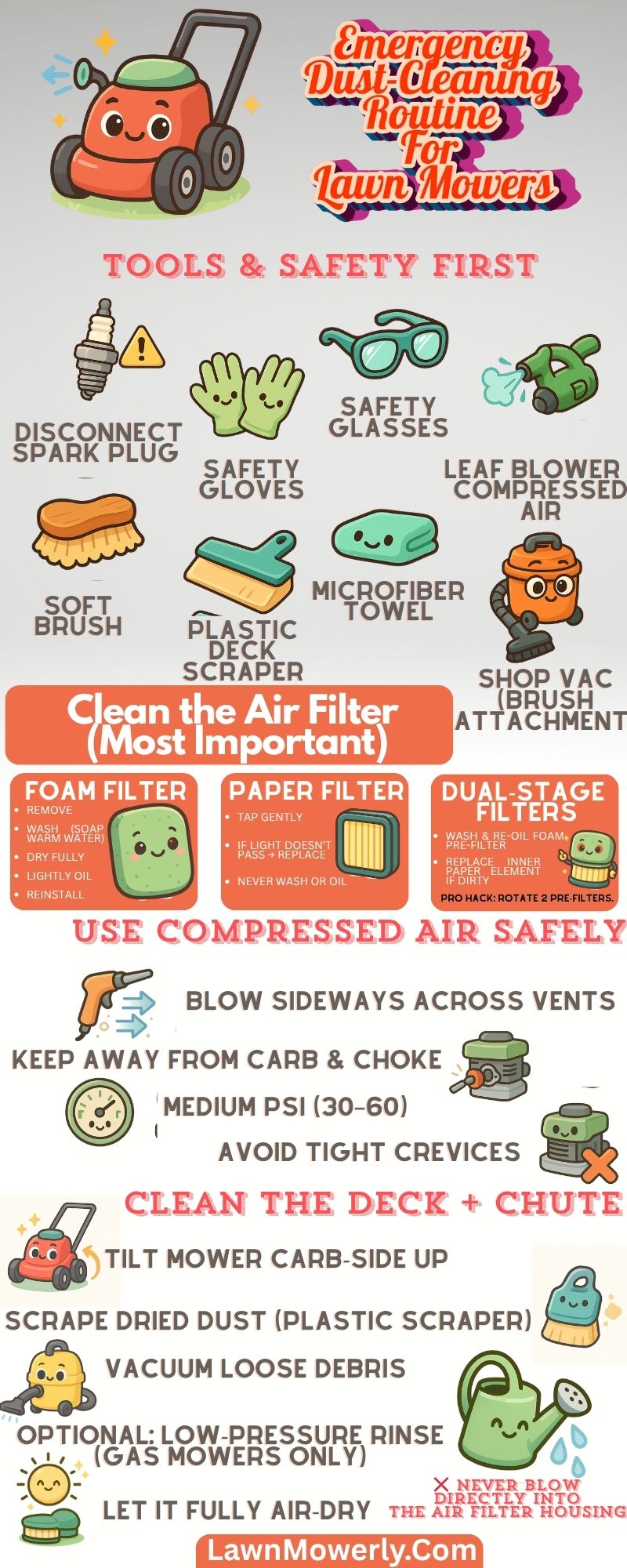
Engine & Fuel System Care After Dusty Conditions
Dust doesn’t just sit on surfaces—it infiltrates your fuel, carburetor, oil, cooling fins, and ignition parts. This section ensures your engine stays protected and performs at full power even after harsh conditions.
1. Air Intake, Carburetor & Throttle Linkage Checks
After dusty jobs:
- Inspect carburetor area for powdery buildup.
- Clean around throttle/choke linkages so they don’t stick.
- Ensure choke plate opens and closes smoothly.
- Check primer bulb (if present) for cracks or dust intrusion.
When to suspect dust inside the carburetor:
- Rough idle
- Surging (revving up & down)
- Hard starting
- Needs half choke to stay running
If symptoms persist, a carb clean or rebuild may be needed.
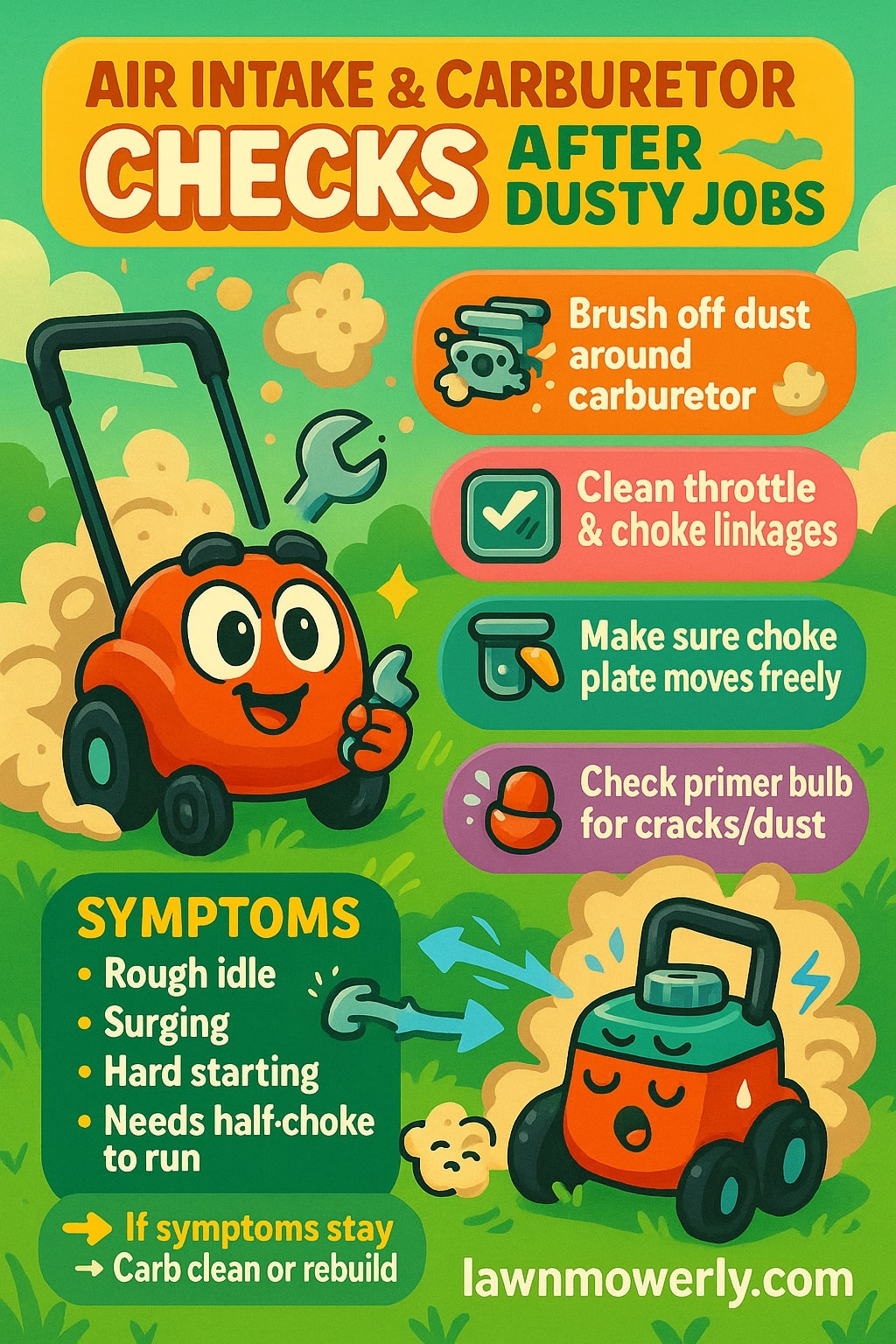
2. Oil Contamination: How to Identify & Fix It
Dusty jobs rapidly accelerate oil contamination.
Check the oil:
- Pull the dipstick → wipe → reinsert → check again.
- Look for:
- Grit
- Cloudiness
- Metallic shimmer
- Dark, sticky residue
If any grit is visible → change oil immediately.
Recommended frequency after dusty work:
- Homeowners in normal conditions: every 25 hours
- Contractors / sandy regions: every 10–15 hours
- Extremely dusty job sites: after every major job
This alone extends engine life dramatically.
3. Spark Plug & Ignition Checks
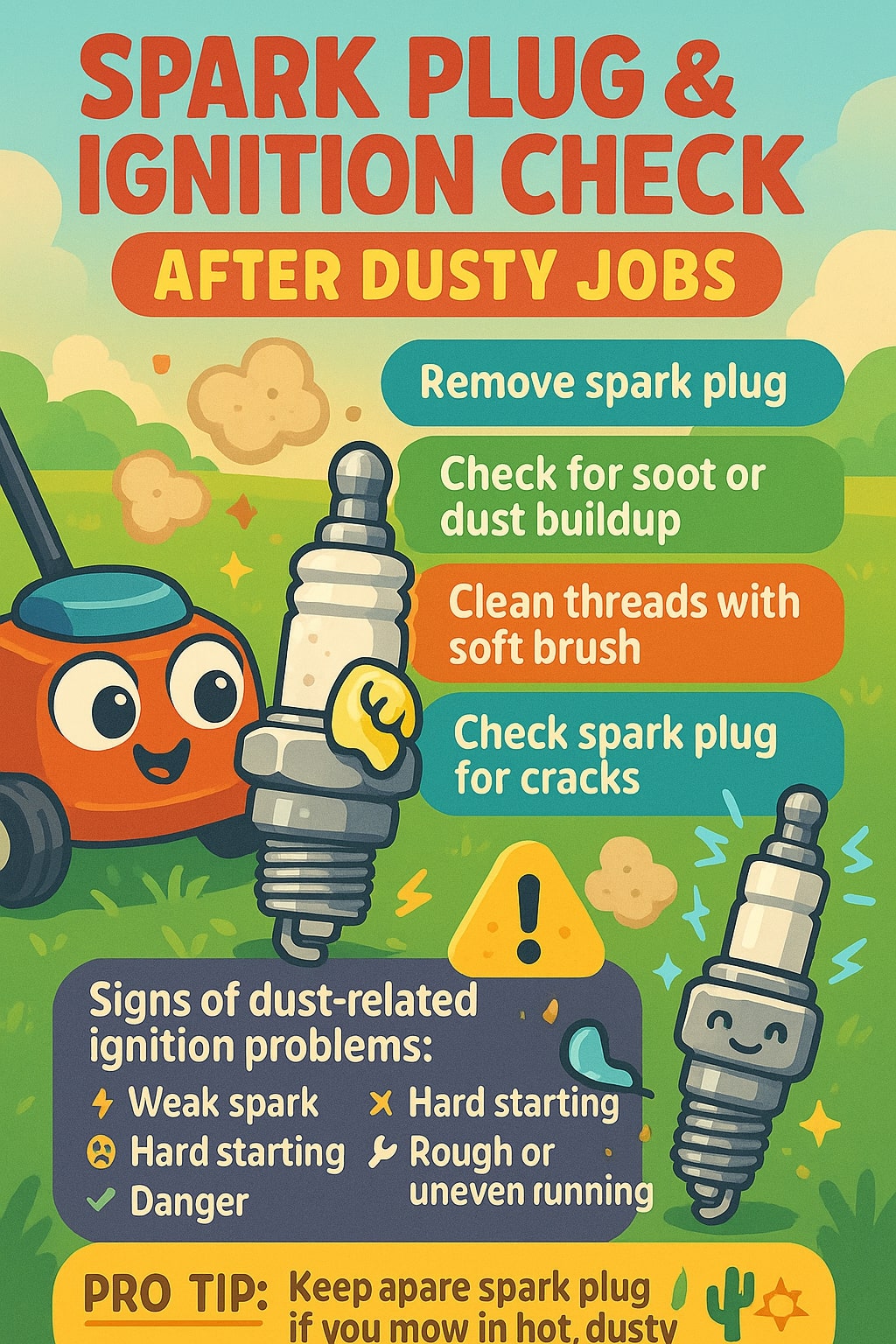
Dust around the ignition system causes:
- Weak spark
- Misfires
- Hard starting
Steps:
- Remove spark plug.
- Inspect for black soot or powdery dust deposits.
- Clean threads with a soft brush.
- Check gap per manufacturer spec.
- Replace if fouled, worn, or corroded.
Pro tip: Keep a spare plug in your garage or truck—spark plugs fail more often in hot, dusty climates like Arizona, Nevada, New Mexico, and West Texas.
4. Cooling System & Engine Fins (The Most Overlooked Area)
Mower engines rely on airflow across cooling fins. Dust + grass clippings form a blanket that traps heat.
Steps:
- Blow dust out of cooling fins on the top and sides.
- Clear debris from around shrouds, recoil housings, and muffler guards.
- Ensure ventilation slots aren’t blocked.
Signs your mower is running too hot:
- Burning smell
- Engine loses power after a few minutes
- Plastic shroud feels excessively hot
- Oil smells burnt or darkens quickly
Keeping fins clean is essential in Southern, Western, and desert climates, where heat builds rapidly.
5. Fuel System Freshness & Stabilization
Dust often settles around the fuel cap and can enter the tank during refueling.
Tips:
- Wipe around the fuel cap before opening it.
- Avoid refueling in high wind or dusty areas.
- Add a fuel stabilizer during hot summers or if the mower will sit unused for a few weeks.
- Inspect fuel lines for cracks (dust accelerates wear).
Lawn Mower Maintenance Schedule & Detailed Checklists
(Professional-Grade Dusty Job Framework)
Dusty conditions don’t just dirty your mower—they completely change your maintenance intervals. Standard homeowner schedules don’t apply. Landscapers, contractors, and anyone mowing dry, sandy, or construction-dust-filled lawns need a tiered maintenance framework that adjusts for dust density, soil type, climate zone, and mower usage frequency.
Below is a multi-level system used by commercial lawn crews across the US, covering daily, weekly, monthly, and seasonal intervals. These schedules work for walk-behind mowers, zero-turns, tractors, electrics, and even robotic units.
1. Daily Post-Dust Mower Maintenance Checklist
(After Every Dusty Mowing Session)
This is your non-negotiable checklist after ANY dusty job, even if the session was short.
2 .Weekly Contractor-Level Mower Maintenance Checklist
If you mow dusty lawns more than once per week, this checklist is essential.
3. Monthly or Every 10–15 Hours (Heavy Dust Regions) Mower Maintenance Checklist
4. Seasonal or Annual Mower Maintenance in Dust-Prone Regions
Printable Mower Maintenance Checklist
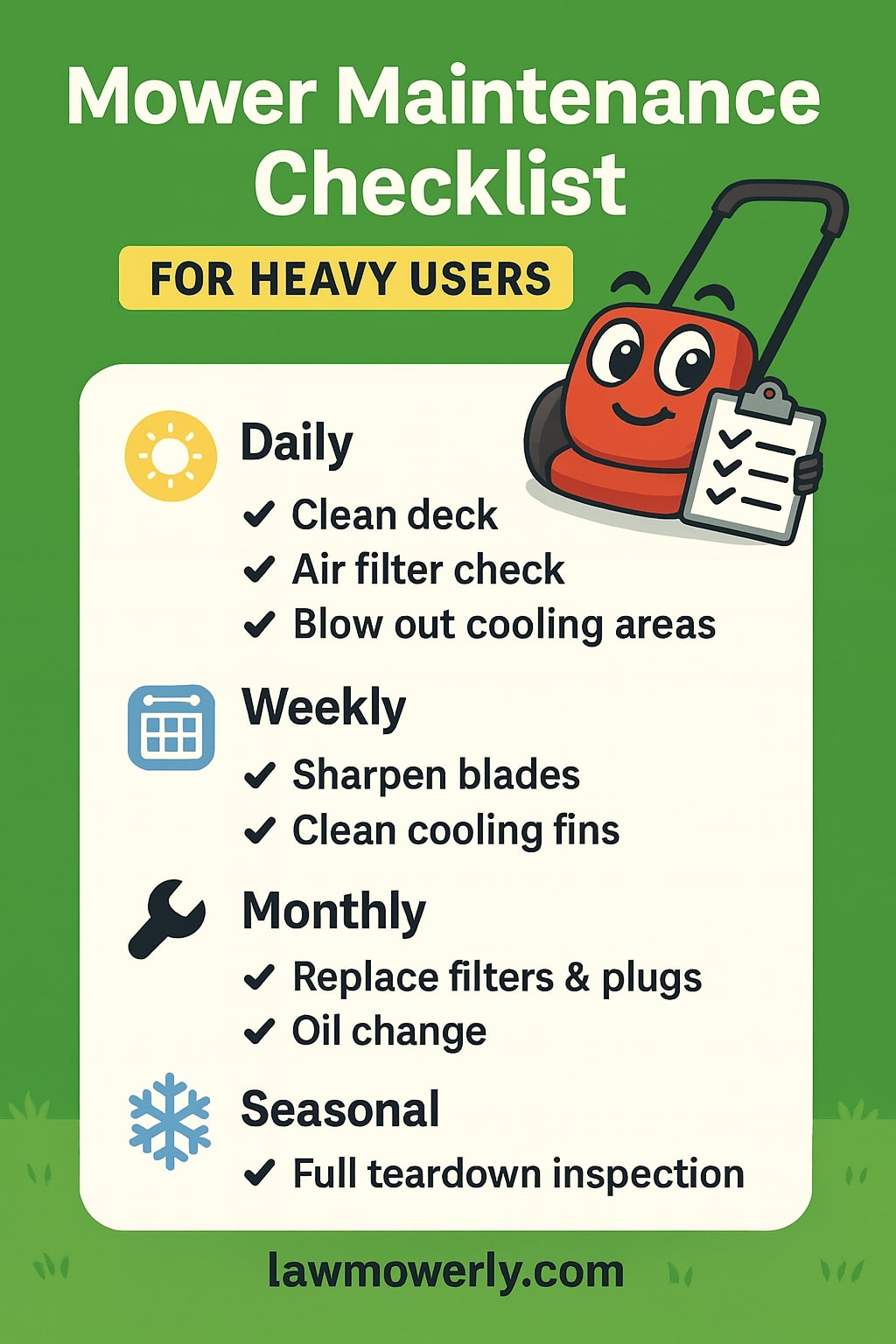
8 Cleaning Mistakes That Cause Engine Damage
- Carburetor jets
- Venturi channels
- Choke plate pivots
- Intake manifold
Paste + engine heat = cement.
On electric mowers, water can short the motor or controller.
On gas engines, it cakes onto cooling fins and reduces heat dissipation.
- Rich-running engine
- Low power
- Black smoke
- Excess fuel consumption
- Cylinder scoring from dust bypass
- Restricts suction
- Weakens blade lift
- Causes uneven cutting
- Overheats the spindle
- Wears out belts prematurely
- Grass looks torn or shredded
- Brown tips appear within 24–48 hours
- Mower feels underpowered
- Mulching becomes poor
In desert climates → as frequently as every 5-8 hours.
If oil feels gritty → your engine is already wearing down.
- Accelerated ring wear
- High friction
- Heat spikes
- Reduced compression over time
- Under the spark plug boot
- Around the porcelain
- On the threads
When to DIY vs. When to Hire a Pro
| Task | DIY? | Call a Pro If… |
|---|---|---|
| Air Filter Service | ✔ Yes | Surging continues after replacement |
| Deck Cleaning | ✔ Yes | Deck vibration persists |
| Blade Sharpening | ✔ Yes | Blade imbalance or spindle wobble |
| Oil Change | ✔ Yes | Metallic particles found in oil |
| Carburetor Cleaning | ⚠ Maybe | Engine still hunts or bogs |
| Cooling Fin Cleaning | ✔ Yes | Overheating continues |
| Electric Motor Cleaning | ⚠ Maybe | Motor whines or shuts off |
| Robotic Sensor Cleaning | ✔ Yes | Navigation errors persist |
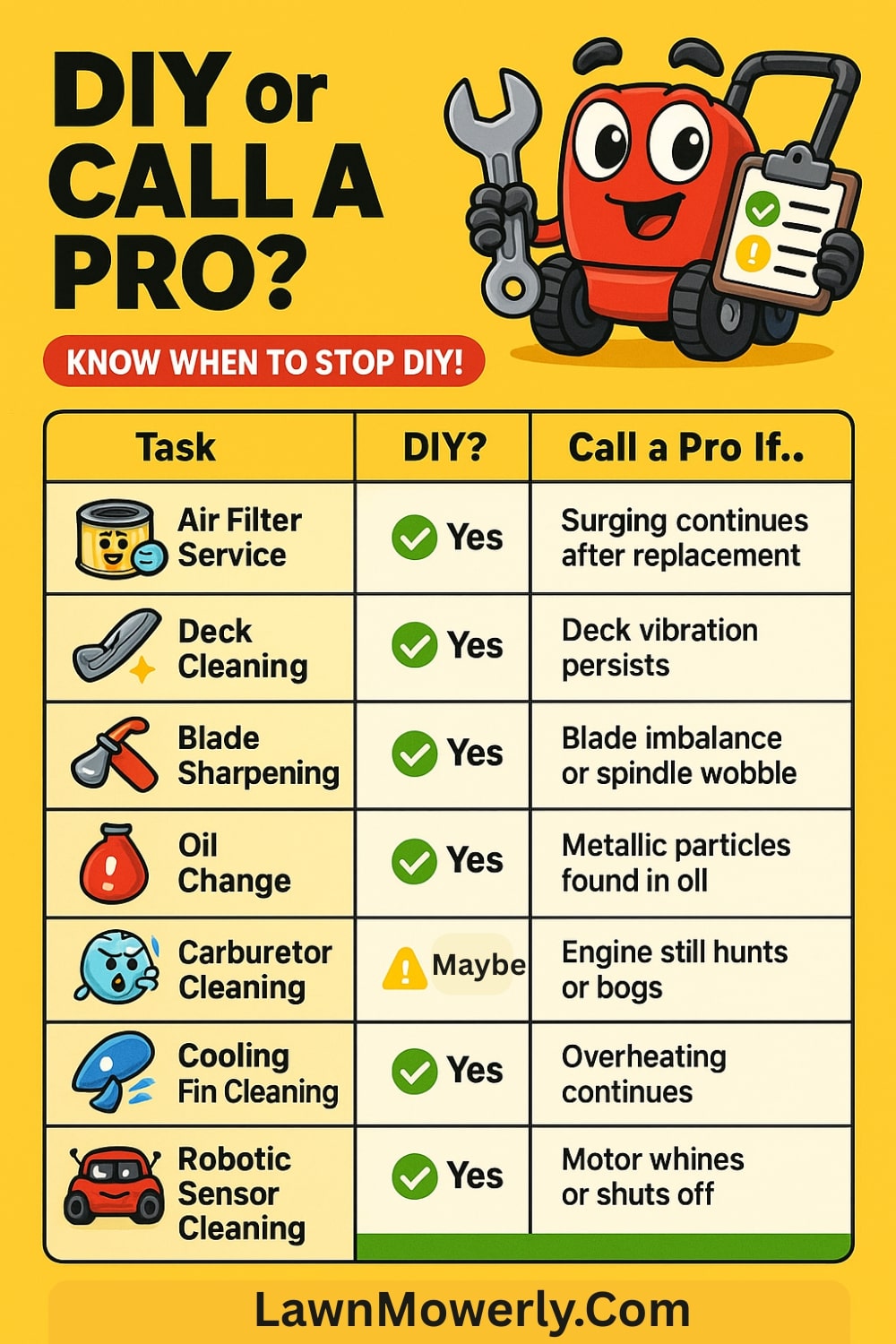
Expert Tips & Pro Shortcuts
(Time-Saving, Performance-Boosting, Contractor-Approved)
These are the same best practices used by professional lawncare companies, heavy-duty contractors, and equipment rental fleets operating in dusty US environments.They’re highly practical—saving time, reducing repairs, and improving performance
- A foam pre-filter around it (captures coarse dust)
- A high-density paper element inside (captures fine dust)
This prevents dust adhesion and reduces buildup by 50–70%.
Common options:
- Silicone deck sprays
- PTFE-based coatings
- Ceramic deck liners
- Always carry a pre-filter for mower in your kit
- Change oil every 10–15 hours max
- Install snorkel-style raised air intakes for commercial ZTRs if mowing construction lots
- Rinse deck with water after dusty mowing (deck only)
- Use marine-grade grease on spindles
- Store indoors—salt destroys engines
- Fall leaf dust requires mid-season filter replacements
- Use high-lift blades to counteract heavy debris load
- Dust storms require daily deck cleaning
- Keep a spare spark plug—wind-driven dust fouls plugs quickly
FAQs
Final Summary
Dusty mowing is one of the harshest conditions for any lawn mower — gas, electric, or robotic.
By cleaning the air filter, clearing the deck, inspecting the blade, blowing out cooling fins, and adjusting your maintenance schedule to your region, you protect your engine, improve performance, and extend equipment life dramatically.
This guide equips homeowners and contractors with a complete, US-specific, professional maintenance system to keep mowers running clean, cool, and powerful in even the dustiest environments.

I’m David man behind Lawn Mowerly; I’ve been dealing with lawnmowers and Tractors with my father since I was a kid. I know every make and model and what each one is capable of and love helping people find the perfect equipment for their needs.

